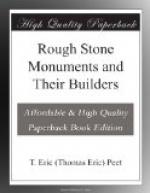At Merivale, in Somersetshire, there are the remains of a small circle, to the north of which lie two almost parallel double lines of menhirs, running about E.N.E. by W.S.W., the more southerly of the two lines overlapping the other at both extremities.
With what purpose were these great circles erected? We have already mentioned the curious belief of Geoffrey of Monmouth with regard to Stonehenge, and we may pass on to more modern theories. James I was once taken to see Stonehenge when on a visit to the Earl of Pembroke at Wilton. He was so interested that he ordered his architect Inigo Jones to enquire into its date and purpose. The architect’s conclusion was that it was a Roman temple “dedicated to the god Caelus and built after the Tuscan order.”
Many years later Dr. Stukeley started a theory which has not entirely been abandoned at the present day. For him Stonehenge and other stone circles were temples of the druids. This was in itself by no means a ridiculous theory, but Stukeley went further than this. Relying on a quaint story in Pliny wherein the druids of Gaul are said to use as a charm a certain magic egg manufactured by snakes, he imagined that the druids were serpent-worshippers, and essayed to see serpents even in the forms of their temples. Thus in the Avebury group the circle on Hakpen Hill was for him the head of a snake and its avenue part of the body. The Avebury circles were coils in the body, which was completed by the addition of imaginary stones and avenues. He also attempted with even less success to see the form of a serpent in other British circle groups.
The druids, as we gather from the rather scanty references in Caesar and other Roman authors, were priests of the Celts in Gaul. Suetonius further speaks of druids in Anglesey, and tradition has it that in Wales and Ireland there were druids in pre-Christian times. But that druids ever existed in England or in a tithe of the places in which megalithic circles and other monuments occur is unlikely. At the same time, it is not impossible that some of the circles of Ireland, Wales, and France were afterwards used by the druids as suitable places for meeting and preaching.
Fergusson in his great work Rude Stone Monuments held a remarkable view as to the purpose of the British stone circles. He believed that they were partly Roman in date, and that some of them at least marked the scene of battles fought by King Arthur against the Saxons. Thus, for example, he says with regard to Avebury, “I feel it will come eventually to be acknowledged that those who fell in Arthur’s twelfth and greatest battle were buried in the ring at Avebury, and that those who survived raised these stones and the mound of Silbury in the vain hope that they would convey to their latest posterity the memory of their prowess.” It is hardly necessary to take this view seriously nowadays. Stonehenge, which Fergusson attributes to the same late era, has been proved by excavation to be prehistoric in origin, and with it naturally go the rest of the megalithic circles of England, except where there is any certain proof to the contrary.




